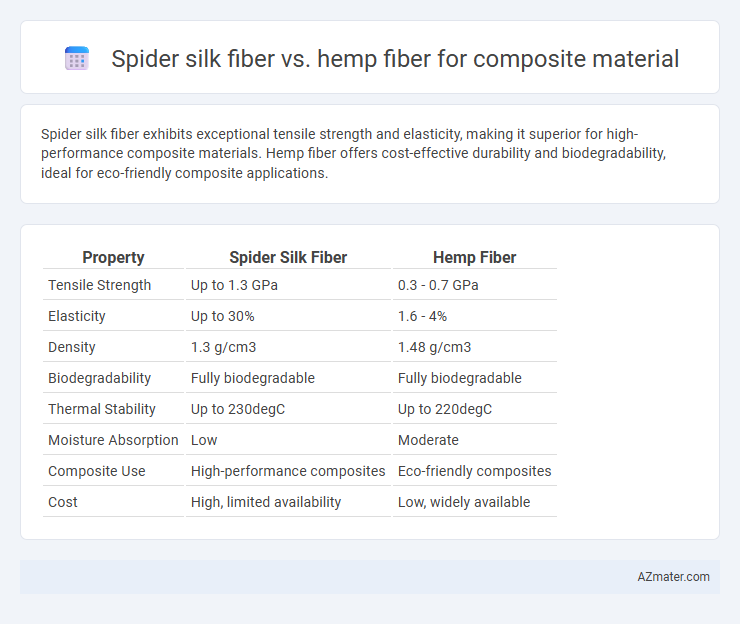Spider silk fiber exhibits exceptional tensile strength and elasticity, making it superior for high-performance composite materials. Hemp fiber offers cost-effective durability and biodegradability, ideal for eco-friendly composite applications.
Table of Comparison
| Property | Spider Silk Fiber | Hemp Fiber |
|---|---|---|
| Tensile Strength | Up to 1.3 GPa | 0.3 - 0.7 GPa |
| Elasticity | Up to 30% | 1.6 - 4% |
| Density | 1.3 g/cm3 | 1.48 g/cm3 |
| Biodegradability | Fully biodegradable | Fully biodegradable |
| Thermal Stability | Up to 230degC | Up to 220degC |
| Moisture Absorption | Low | Moderate |
| Composite Use | High-performance composites | Eco-friendly composites |
| Cost | High, limited availability | Low, widely available |
Introduction to Spider Silk and Hemp Fibers
Spider silk fiber exhibits exceptional tensile strength, elasticity, and biocompatibility, making it a premium choice for advanced composite materials. Hemp fiber offers sustainability advantages, high cellulose content, and durability, widely used in eco-friendly composites. Both fibers provide unique mechanical properties and environmental benefits crucial for next-generation composite applications.
Overview of Composite Materials
Spider silk fiber offers exceptional tensile strength and elasticity, making it ideal for lightweight composite materials requiring high durability and flexibility. Hemp fiber provides excellent stiffness, biodegradability, and cost-effectiveness, commonly used in composites targeting sustainability and environmental friendliness. Both fibers enhance composite performance, with spider silk focusing on superior mechanical properties and hemp emphasizing eco-friendly applications.
Mechanical Properties Comparison
Spider silk fiber exhibits exceptional tensile strength and elasticity, surpassing hemp fiber with tensile strengths up to 1.3 GPa and elongation at break reaching 30%, compared to hemp fiber's tensile strength around 550 MPa and elongation of 2-4%. The superior toughness and energy absorption capacity of spider silk make it ideal for high-performance composite materials requiring flexibility and durability. Hemp fiber offers good stiffness and biodegradability but lags behind spider silk in mechanical resilience and adaptive strain capabilities.
Strength and Toughness Analysis
Spider silk fiber demonstrates exceptional tensile strength, often surpassing steel by weight, making it highly suitable for composite materials requiring lightweight yet durable components. Hemp fiber offers notable toughness with good elongation properties and high impact resistance, contributing to composites that benefit from flexibility and energy absorption. When analyzing strength and toughness, spider silk fibers provide superior strength-to-weight ratios, while hemp fibers enhance composite toughness and durability through their natural lignocellulosic structure.
Sustainability and Environmental Impact
Spider silk fiber exhibits superior sustainability compared to hemp fiber due to its biodegradability, minimal land and water usage, and low carbon footprint during production. Hemp fiber, while renewable and requiring fewer pesticides, demands considerable agricultural resources and may involve energy-intensive processing, impacting its overall environmental advantage. Both fibers contribute to eco-friendly composites, but spider silk's natural production efficiency and environmental compatibility position it as a more sustainable choice for green material innovation.
Processing and Fabrication Techniques
Spider silk fiber offers exceptional tensile strength and elasticity, enabling advanced fabrication techniques such as wet spinning and electrospinning to create continuous fibers for composite reinforcement. Hemp fiber, known for its biodegradability and cost-effectiveness, is commonly processed through retting, decortication, and combing before being integrated via traditional mechanical weaving or nonwoven matting techniques. Composite manufacturing with spider silk fibers demands precise control of environmental factors during solvent-based spinning, whereas hemp fibers are compatible with standard resin infusion and compression molding processes, facilitating scalable production.
Cost and Scalability Considerations
Spider silk fiber offers exceptional mechanical properties but remains prohibitively expensive and difficult to produce at scale due to complex bioengineering requirements. Hemp fiber provides a cost-effective and highly scalable alternative, with established agricultural processes supporting large-volume composite material production. Cost-efficiency and scalability make hemp fiber the preferred choice for commercial composite manufacturing despite spider silk's superior strength-to-weight ratio.
Applications in Industry
Spider silk fiber exhibits exceptional tensile strength, elasticity, and lightweight properties, making it ideal for aerospace and biomedical composites requiring high performance and durability. Hemp fiber offers cost-effective, sustainable reinforcement with good mechanical properties and biodegradability, widely applied in automotive panels, construction materials, and consumer goods. Both fibers enhance composite materials, with spider silk favored in advanced, high-tech applications and hemp in eco-friendly, large-scale manufacturing.
Limitations and Challenges
Spider silk fiber exhibits exceptional tensile strength and elasticity but faces significant scalability challenges due to difficulties in large-scale harvesting and high production costs. Hemp fiber, while more abundant and cost-effective, suffers from lower mechanical performance and variability in fiber quality, which affects composite consistency. Both fibers present processing challenges such as compatibility with polymer matrices and moisture absorption that impact the durability and overall performance of composite materials.
Future Perspectives and Innovations
Spider silk fiber exhibits remarkable tensile strength, elasticity, and biodegradability, making it a promising material for next-generation composite applications in aerospace and biomedicine. Innovations in recombinant protein production and genetic engineering are enhancing spider silk scalability and cost-effectiveness compared to traditional hemp fiber, which is valued for its durability and sustainability but lacks spider silk's superior mechanical properties. Future perspectives emphasize biohybrid composites integrating spider silk with hemp to optimize performance, reduce environmental impact, and drive advances in lightweight, high-strength materials.

Infographic: Spider silk fiber vs Hemp fiber for Composite material
 azmater.com
azmater.com